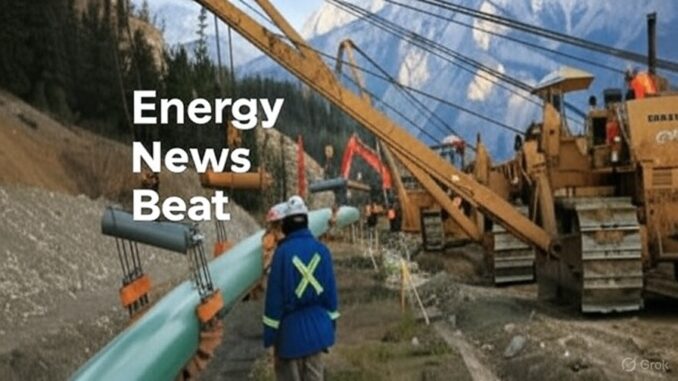
In a significant shift in global energy dynamics, China has overtaken the United States as Canada’s largest crude oil customer in recent months, largely thanks to the expanded Trans Mountain pipeline (TMX). This development marks a diversification of Canadian energy exports away from near-total reliance on the U.S. market, which has dominated for decades. The change comes amid rising Asian demand, geopolitical tensions, and infrastructure advancements that have unlocked new shipping routes. However, this pivot raises questions about past policy decisions, including Prime Minister Justin Trudeau’s 2022 assertion that there was “no strong business case” for exporting liquefied natural gas (LNG) and related energy infrastructure to certain markets.
The Rise of China in Canadian Oil Exports
Canada’s crude oil exports have seen steady growth over the past several years, driven by increased production from Alberta’s oil sands. Total exports averaged around 3.7 million barrels per day (MMb/d) in 2020, climbing to 4.20 MMb/d in 2024, with projections for further increases in 2025.
Heavy oil constitutes the bulk, making up 79% of exports in 2024 at 3.33 MMb/d.
Historically, the U.S. absorbed over 95% of these volumes, with Canada supplying more than 60% of U.S. crude imports—equating to about 4.18 MMb/d in 2024, up from 3.95 MMb/d in 2022 and 3.90 MMb/d in 2023.
This made Canada the U.S.’s top foreign supplier by a wide margin, nine times larger than the next (Mexico).
Exports to the U.S. Midwest (PADD 2) dominate, at around 2.8 MMb/d in 2024, with full market share due to landlocked infrastructure.
However, direct exports to China were negligible before 2024, often routed indirectly via U.S. Gulf Coast re-exports (averaging 200,000 bpd in 2023).
This changed dramatically with the TMX expansion, which went operational in mid-2024, boosting capacity to 890,000 bpd and providing tidewater access from British Columbia.
From the pipeline’s launch through spring 2025, average flows to China reached 207,000 bpd, surpassing the 173,000 bpd to the U.S. via TMX.
By October 2025, up to 70% of crude shipments from British Columbia headed to Chinese ports, with 5 million barrels shipped from Vancouver in the first half of the month—a record high.
The value of crude exports to China jumped from nearly zero in 2023 to $2.45 billion in 2024, reflecting this volume surge.
Overall, China’s imports from Canada hit $4.74 billion in 2024, driven by new storage capacity (169 million barrels added in 2024-2025) and stockpiling at around 990,000 bpd year-to-date.
This shift has displaced U.S. dominance in Canadian oil flows from the West Coast, though total U.S. imports from Canada remain robust.
|
Year
|
Total Canadian Crude Exports (MMb/d)
|
Exports to U.S. (MMb/d)
|
Direct Exports to China (bpd, approx.)
|
|---|---|---|---|
|
2020
|
~3.68
|
~3.80
|
Negligible
|
|
2021
|
~3.80 (est.)
|
~3.85 (est.)
|
Negligible
|
|
2022
|
~3.95
|
3.95
|
Negligible
|
|
2023
|
~3.98
|
3.90
|
~0 (direct; re-exports ~200k)
|
|
2024
|
4.20
|
3.93
|
~200k (avg. post-TMX)
|
|
2025
|
~4.50 (proj.)
|
~4.18 (YTD)
|
>207k (YTD; Oct record high)
|
LNG Exports: From Zero to Global Player
Unlike oil, Canada’s LNG exports were virtually nonexistent from 2020 to mid-2025, limited by a lack of export facilities despite abundant natural gas production. Natural gas exports (pipeline, not LNG) averaged 8.8 billion cubic feet per day (Bcf/d) in 2024, all to the U.S., representing 47.8% of Canadian production—a modest 3.5% increase from 2020 levels.
Values hovered around $8-13 billion annually, far below oil’s $153 billion in 2024.
This changed in June 2025 with the first cargo from LNG Canada in Kitimat, B.C.—the country’s inaugural large-scale LNG export facility.
The project, with 1.8 Bcf/d capacity (Phase I), shipped its debut load to Asia, targeting markets like South Korea and Japan.
Additional projects like Woodfibre LNG (0.29 Bcf/d, expected 2027-2028) and Cedar LNG (0.4 Bcf/d, 2028-2029) are in development, potentially adding up to 6.5 Bcf/d total capacity.
These facilities emphasize low emissions, with LNG Canada at 0.15 tonnes CO2e per tonne—60% below global averages.
Prior to 2025, Canada missed out on the global LNG boom; exports could have displaced significant coal emissions in Asia if started earlier (e.g., equivalent to Canada’s annual domestic emissions between 2020-2022).
Now, with shipments to Asia, Canada is positioned to compete with U.S. and Qatari exporters, benefiting from shorter shipping routes (50% fewer days to North Asia).
Was Trudeau Right About ‘No Money’ in LNG and Oil Exports?
In August 2022, Prime Minister Trudeau stated there was “never a strong business case” for LNG exports from Canada’s East Coast to Europe, citing high costs, logistical challenges, and distance.
He extended similar skepticism to pipelines and LNG broadly, turning down opportunities with Germany and Japan.
For oil, while not directly quoted on “no money,” his government’s delays on projects like TMX (originally approved in 2016 but expanded in 2024) implied similar caution.
Recent developments suggest he underestimated the potential. The TMX has enabled profitable oil exports to China, with Western Canadian Select prices at multi-year highs despite global slumps.
Oil sands production is set to hit 3.5 MMb/d in 2025 and 3.9 MMb/d by 2030, supporting diversification.
On LNG, the successful launch of LNG Canada—backed by Asian investors like PetroChina and KOGAS—demonstrates a viable business case for Asia, where demand is booming as countries shift from coal.
Critics argue Canada could have captured more market share earlier, potentially reducing global emissions and boosting revenues.
While Trudeau’s focus on Europe may hold for direct shipments due to economics, the Asian opportunity proves there is indeed “money” in exporting LNG and oil—evidenced by $160 billion in combined oil and gas export revenues in 2024 alone.
As Canada ramps up, the energy sector’s future looks brighter, but policy hindsight highlights missed chances.
Got Questions on investing in oil and gas? Or do you have a Tax Burden in 2025?
Crude Oil, LNG, Jet Fuel price quote
ENB Top News
ENB
Energy Dashboard
ENB Podcast
ENB Substack






